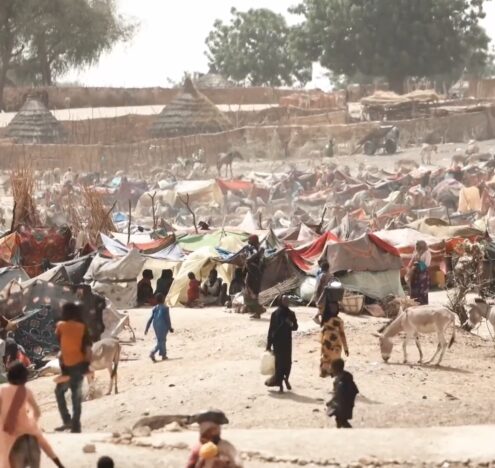The climate crisis is one of the foremost challenges facing the United States and the world today. In recognition of the severity of this global threat, President Joe Biden used his first day in office to rejoin the Paris Agreement, restore a series of public health and environmental rules, and cancel the permit to the Keystone XL oil pipeline.
As part of the “After the Apocalypse” series — a set of policy recommendations to help guide us out of a time that has frequently felt like the end of the world — Inkstick asked Dominique Browning, Kate Guy, Josh Gellers, and Elsie Fukofuka how the Biden administration should continue to respond to this threat. The climate crisis touches virtually every aspect of our lives and the recommendations reflect the broad range of domestic and international efforts needed, from reducing climate pollution to financially supporting front-line, vulnerable communities.
Their recommendations are as follows:
Dominique Browning, Co-Founder and Head of Moms Clean Air Force
- Use the power of the Presidency to cut pollution and address the climate crisis. That means scrupulously prioritizing climate and air quality in every executive order, every bill, and with every nominee put forward. The climate crisis is central to this administration’s plan to rebuild our country in a safe and equitable manner, and moms are ready to make sure that they do so. We expect enormous strides in reducing climate change and air pollution, while righting the wrongs of environmental injustice. That means, fixing these rollbacks that harm our climate and air quality; restoring strong regulation; cutting pollution from the transportation and power sectors; restoring science as the foundation for health-protective standards that keep our air clean; ending environmental injustice and investing in clean energy.
- Eliminate climate pollution from cars and trucks — the largest US source of climate pollution – by 2040. The president must move quickly to implement a massive build-out of electric vehicle charging infrastructure across the country. But electric vehicles are just one side of the climate equation; the other is the electricity itself, which must be cleaned up. To realize this goal, the incoming Biden administration must reverse the damage done at the Environmental Protection Agency through the Trump administration’s multiple regulatory rollbacks of tailpipe emissions standards for cars, carbon emissions standards for power plants, and methane emissions standards for oil and gas operations — just to name a few. The president-elect must also use the regulatory power of the EPA to slash climate pollution even further in the energy and transportation sectors.
- Pass comprehensive climate legislation, with strong bipartisan support, that safeguards our children’s health and future, jumpstarts rapid deployment of clean energy sources, delivers on the moral imperative of Justice in Every Breath, and opens the floodgates of new American jobs to support a clean energy economy. Our children deserve nothing less.
Kate Guy, Senior Research Fellow at the Center for Climate and Security
- Reinvent US climate leadership. The Trump Administration brought American investment in global institutions to an all-time low, and as a result, cooperation around world problems has dangerously backtracked. Meanwhile, climate change is creating a host of new-fangled global problems, from disrupted food supply chains, to development of geo-engineering technologies, to the plight of climate migrants. We find ourselves in a moment similar to that of the post-WWII era: lacking global institutions that are fit to address the challenges of a climate-changed world. A newly-engaged US rising to address the diverse impacts of the climate crisis is an opportunity to reverse this trajectory. The Biden Administration should use its full convening and diplomatic power to examine these next generation issues, including by investing in creative governance options to mitigate them.
- Prioritize climate in security. One area demanding urgent attention is improving our understanding of the threats climate change poses to US national security. Security leaders should task scientists, intelligence analysts, and regional experts across the government with developing comprehensive climate threat assessments that forecast how rising temperatures will impact global security and interests. From there, these inputs should form the basis of more holistic security and defense strategies, which incorporate mitigating climate risk and improving human security outcomes at the center of US efforts.
- Marshall Plan for the climate: The Biden Administration is positioning itself to go big and bold in its domestic legislation, and should apply the same mindset to its global engagement. To provide an alternative to the Chinese Belt and Road Initiative, help economies devastated by the coronavirus and to invest seriously in improving climate resilience, some have proposed a sweeping new Marshall Plan-style investment program oriented towards building clean technologies and adaptation efforts in developing countries. These are the type of ambitious efforts that we need to address the daunting threats of climate change, and would help define the future of a United States helping aid the most vulnerable around the world.
Josh Gellers, Associate Professor at the University of North Florida and Research Fellow at the Earth System Governance Project
- Address inequity. During the previous Congress, then-Senator Kamala Harris introduced the Climate Equity Act of 2020, but it was not taken up for a vote. Importantly, this bill recognized environmental rights and mandated that any legislation dealing with an “environmental or climate change nexus” be complemented by an analysis of the impacts that such legislation might have on frontline communities. President Biden made environmental justice a key element of his environmental platform and he has already formed a new Office of Domestic Climate Policy. The next step should involve urging Congress to reintroduce and pass a revised version of the Climate Equity Act in order to mainstream environmental and climate change concerns in the legislative process.
- Advance climate justice. In 2014, President Obama pledged $3 billion to the Green Climate Fund (GCF) to support climate adaptation and mitigation projects throughout the developing world. However, the US has only contributed $1 billion to this pot so far. The United States bears substantial historical responsibility for contributing to climate change as the single largest emitter of CO2 and the last four years saw an abdication of American leadership in the area of climate diplomacy. Given the US’s ethical obligation to combat climate change and the opportunity to demonstrate renewed resolve to tackle this important issue, the Biden administration should seek to fulfill President Obama’s commitment by disbursing the remaining monies to the GCF.
- City moonshot: As the United States continues to urbanize, cities will swell in size and their ecological footprints will balloon as well. This trend holds important implications for national efforts to address climate change. The latest estimates show that US CO2 emissions are driven primarily by transportation (34%) and electricity (32%), sectors highly relevant to cities. Therefore, in order to achieve emissions reductions in line with our renewed obligations under the Paris Climate Accord, the Biden administration should launch a “moonshot” effort to redesign our nation’s major cities so that they are more equitable, sustainable, and resilient for all.
Elsie Fukofuka, Senior Officer in the Ministry of Foreign Affairs in Tonga
The Pacific has come together as a region and issued the “Kainaki II Declaration for Urgent Climate Action Now” calling for more action by the international community, including the United States, to:
- Raise ambition on Nationally Determined Contributions and long-term strategies. Climate change poses an existential threat to the security of Small Island Developing States in the Pacific who are at the forefront of this global crisis. We would like to see the United States exceed their Nationally Determined Contributions (NDCs) in order to pursue global efforts to limit global warming to 1.5 ⁰C. Limiting warming to well below 1.5 ⁰C above pre-industrial levels will significantly reduce risks and adaptation needs, as well as prevent irreversible loss and permanent damage to our environment, society, economy and, more importantly, our existence. In addition, we would like to see the US formulate and communicate mid-century, long-term low emissions development strategies. This may include commitments and strategies to achieve net zero carbon by 2050.
- Safeguard our oceans. The ocean is central to Pacific identity, culture and economies. 96% of the region is Blue Pacific Ocean and revenue from marine resources is a critical source of government revenue. However, record high carbon dioxide levels are causing seas to rise, oceans to warm, coral reefs to bleach and are altering the migratory patterns of tuna in Pacific waters. We’d like to see the US take immediate action to prevent the irreversible impacts of climate change on our oceans, to ensure clean, healthy and productive oceans for generations to come. This includes commitments and strategies for oceans conservation such as the UK’s 30by30. The Pacific also welcomes increased investment by the US in establishing observation systems to understand the impacts of climate change on the oceans, blue carbon protection, and restoration initiatives for climate mitigation and adaptation, as well as monitoring to strengthen natural disaster response and risk reduction strategies for our islands.
- Raise ambition on climate finance and Pacific assistance. Climate finance is of critical importance to assisting Pacific island states with the loss and damage associated with climate impacts, as well as mitigation and adaptation efforts. In Tonga, for example, the near to medium term impacts of climate change will result in the permanent loss of our land and ocean resources, and irreversible damage to our economy, infrastructure, food, and water security. We’d like to see the US assist Pacific Island states by facilitating their call for access to financing for the loss and damage associated with the impacts of climate change. The US and developed countries must continue to take the lead in mobilising climate finance from a wide variety of sources, instruments, and channels to help meet the global climate finance commitment of $100 billion per year by 2020. We’d also like to see greater climate financing flows to the Pacific region, noting that over the past decade, only about 2% of the global climate finance target expected to be mobilised by 2020 was approved for the Pacific region. Access to these financial mechanisms must also be streamlined and improved.
Also check out After the Apocalypse: Cybersecurity and After the Apocalypse: Iran.





















